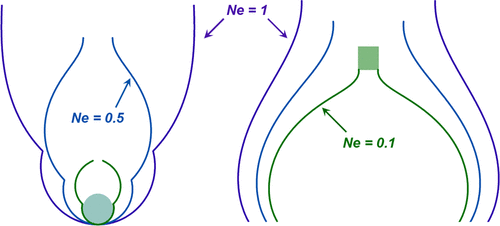Our official English website, www.x-mol.net, welcomes your feedback! (Note: you will need to create a separate account there.)
Compound Drop Shape Analysis with the Neumann Number.
Langmuir ( IF 3.9 ) Pub Date : 2020-06-10 , DOI: 10.1021/acs.langmuir.0c01216 Guangle Li 1 , Gabriel Robles Del Hierro 1 , Jimmy Z Di 1 , Yi Y Zuo 1
Langmuir ( IF 3.9 ) Pub Date : 2020-06-10 , DOI: 10.1021/acs.langmuir.0c01216 Guangle Li 1 , Gabriel Robles Del Hierro 1 , Jimmy Z Di 1 , Yi Y Zuo 1
Affiliation

|
A compound droplet is composed of a traditional pendant drop (PD) or sessile drop (SD) sharing the interface with an immiscible phase of comparable sizes, which could be a solid particle, a gas bubble, or most often another droplet of an immiscible liquid. Over the past decade, the study of compound droplets has attracted increasing attention because of extensive applications in many research fields, such as complex fluids, microfluidics, foam and emulsion, and biomedical applications. Among all technical difficulties in characterizing compound droplets, a central problem in surface science is the prediction of its equilibrium shape, which requires knowledge of complicated boundary conditions. Existing dimensionless groups, such as the Bond number traditionally used to evaluate the shape of PDs and SDs, largely fail in predicting the shape of compound droplets. Here, we propose an alternative Bond number, termed the Neumann number, to characterize the shape of compound droplets. Using three dimensionless groups, that is, the Neumann number, the Bond number, and the Worthington number, we have quantitatively predicted and analyzed the shape of traditional PDs/SDs and various compound droplets, including a PD with a spherical particle suspending at the drop apex, a SD with its apex disturbed by a vertical cylinder, and a spherical SD (no gravity) with its apex disturbed by a fluid lens. It is found that the Neumann number can be readily adapted to quantitatively predict and analyze the shape of PDs/SDs and compound droplets.
中文翻译:

具有诺伊曼数的复合液滴形状分析。
复合液滴由传统的悬滴(PD)或无柄液滴(SD)组成,它们的界面与可比较大小的不溶混相共享,该相可能是固体颗粒,气泡,或者最常见的是另一个不溶混液体的液滴。在过去的十年中,由于在许多研究领域中的广泛应用,例如复杂流体,微流体,泡沫和乳液以及生物医学应用,对复合液滴的研究已引起越来越多的关注。在表征复合液滴的所有技术难题中,表面科学的中心问题是其平衡形状的预测,这需要了解复杂的边界条件。现有的无量纲组,例如传统上用于评估PD和SD形状的邦德数,在很大程度上无法预测复合液滴的形状。在这里,我们提出了另一种键值,称为诺伊曼数,以表征复合液滴的形状。使用三个无因次组,即诺伊曼数,邦德数和沃辛顿数,我们已经定量预测和分析了传统PD / SD的形状以及各种复合液滴,包括具有悬浮在液滴上的球形颗粒的PD顶点,SD的顶点被竖直圆柱体干扰,球形SD(无重力)的顶点被流体透镜干扰。已发现,诺伊曼数可以很容易地用于定量预测和分析PD / SD和化合物液滴的形状。表征复合液滴的形状。使用三个无因次组,即诺伊曼数,邦德数和沃辛顿数,我们已经定量预测和分析了传统PD / SD的形状以及各种复合液滴,包括具有悬浮在液滴上的球形颗粒的PD顶点,SD的顶点被垂直圆柱体干扰,球形SD(无重力)的顶点被流体透镜干扰。已经发现,诺伊曼数可以很容易地用于定量预测和分析PD / SD和化合物液滴的形状。表征复合液滴的形状。使用三个无因次组,即诺伊曼数,邦德数和沃辛顿数,我们已经定量预测和分析了传统PD / SD的形状以及各种复合液滴,包括具有悬浮在液滴上的球形颗粒的PD顶点,SD的顶点被垂直圆柱体干扰,球形SD(无重力)的顶点被流体透镜干扰。已经发现,诺伊曼数可以很容易地用于定量预测和分析PD / SD和化合物液滴的形状。包括具有悬浮在液滴顶点的球形颗粒的PD,其顶点被垂直圆柱体干扰的SD,以及其顶点被流体透镜干扰的球形SD(无重力)。已经发现,诺伊曼数可以很容易地用于定量预测和分析PD / SD和化合物液滴的形状。包括具有悬浮在液滴顶点的球形颗粒的PD,其顶点被垂直圆柱体干扰的SD,以及其顶点被流体透镜干扰的球形SD(无重力)。已经发现,诺伊曼数可以很容易地用于定量预测和分析PD / SD和化合物液滴的形状。
更新日期:2020-07-07
中文翻译:

具有诺伊曼数的复合液滴形状分析。
复合液滴由传统的悬滴(PD)或无柄液滴(SD)组成,它们的界面与可比较大小的不溶混相共享,该相可能是固体颗粒,气泡,或者最常见的是另一个不溶混液体的液滴。在过去的十年中,由于在许多研究领域中的广泛应用,例如复杂流体,微流体,泡沫和乳液以及生物医学应用,对复合液滴的研究已引起越来越多的关注。在表征复合液滴的所有技术难题中,表面科学的中心问题是其平衡形状的预测,这需要了解复杂的边界条件。现有的无量纲组,例如传统上用于评估PD和SD形状的邦德数,在很大程度上无法预测复合液滴的形状。在这里,我们提出了另一种键值,称为诺伊曼数,以表征复合液滴的形状。使用三个无因次组,即诺伊曼数,邦德数和沃辛顿数,我们已经定量预测和分析了传统PD / SD的形状以及各种复合液滴,包括具有悬浮在液滴上的球形颗粒的PD顶点,SD的顶点被竖直圆柱体干扰,球形SD(无重力)的顶点被流体透镜干扰。已发现,诺伊曼数可以很容易地用于定量预测和分析PD / SD和化合物液滴的形状。表征复合液滴的形状。使用三个无因次组,即诺伊曼数,邦德数和沃辛顿数,我们已经定量预测和分析了传统PD / SD的形状以及各种复合液滴,包括具有悬浮在液滴上的球形颗粒的PD顶点,SD的顶点被垂直圆柱体干扰,球形SD(无重力)的顶点被流体透镜干扰。已经发现,诺伊曼数可以很容易地用于定量预测和分析PD / SD和化合物液滴的形状。表征复合液滴的形状。使用三个无因次组,即诺伊曼数,邦德数和沃辛顿数,我们已经定量预测和分析了传统PD / SD的形状以及各种复合液滴,包括具有悬浮在液滴上的球形颗粒的PD顶点,SD的顶点被垂直圆柱体干扰,球形SD(无重力)的顶点被流体透镜干扰。已经发现,诺伊曼数可以很容易地用于定量预测和分析PD / SD和化合物液滴的形状。包括具有悬浮在液滴顶点的球形颗粒的PD,其顶点被垂直圆柱体干扰的SD,以及其顶点被流体透镜干扰的球形SD(无重力)。已经发现,诺伊曼数可以很容易地用于定量预测和分析PD / SD和化合物液滴的形状。包括具有悬浮在液滴顶点的球形颗粒的PD,其顶点被垂直圆柱体干扰的SD,以及其顶点被流体透镜干扰的球形SD(无重力)。已经发现,诺伊曼数可以很容易地用于定量预测和分析PD / SD和化合物液滴的形状。



























 京公网安备 11010802027423号
京公网安备 11010802027423号